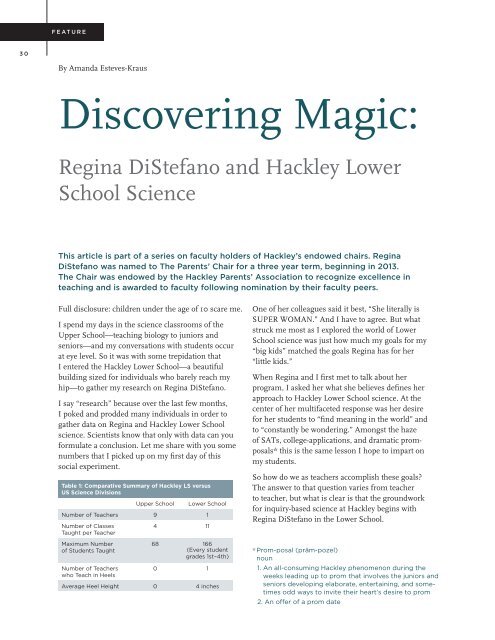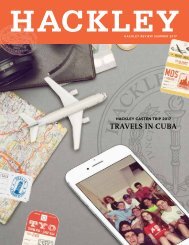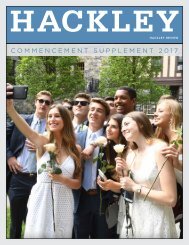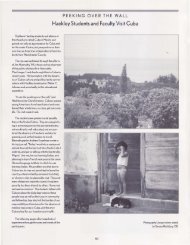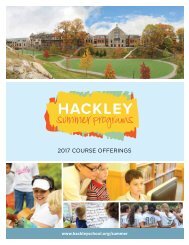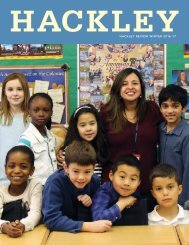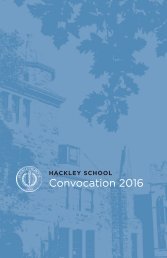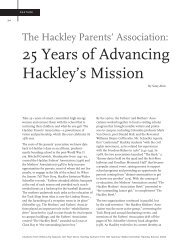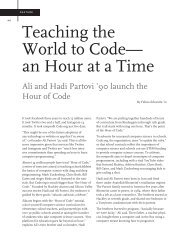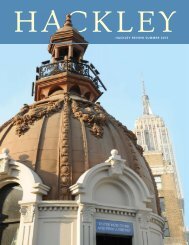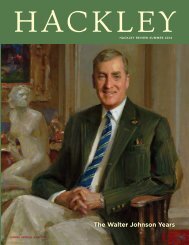Hackley Review Summer 2015: Lower School Science
You also want an ePaper? Increase the reach of your titles
YUMPU automatically turns print PDFs into web optimized ePapers that Google loves.
FEATURE<br />
30<br />
By Amanda Esteves-Kraus<br />
Discovering Magic:<br />
Regina DiStefano and <strong>Hackley</strong> <strong>Lower</strong><br />
<strong>School</strong> <strong>Science</strong><br />
This article is part of a series on faculty holders of <strong>Hackley</strong>’s endowed chairs. Regina<br />
DiStefano was named to The Parents’ Chair for a three year term, beginning in 2013.<br />
The Chair was endowed by the <strong>Hackley</strong> Parents’ Association to recognize excellence in<br />
teaching and is awarded to faculty following nomination by their faculty peers.<br />
Full disclosure: children under the age of 10 scare me.<br />
I spend my days in the science classrooms of the<br />
Upper <strong>School</strong>—teaching biology to juniors and<br />
seniors—and my conversations with students occur<br />
at eye level. So it was with some trepidation that<br />
I entered the <strong>Hackley</strong> <strong>Lower</strong> <strong>School</strong>—a beautiful<br />
building sized for individuals who barely reach my<br />
hip—to gather my research on Regina DiStefano.<br />
I say “research” because over the last few months,<br />
I poked and prodded many individuals in order to<br />
gather data on Regina and <strong>Hackley</strong> <strong>Lower</strong> <strong>School</strong><br />
science. Scientists know that only with data can you<br />
formulate a conclusion. Let me share with you some<br />
numbers that I picked up on my first day of this<br />
social experiment.<br />
Table 1: Comparative Summary of <strong>Hackley</strong> LS versus<br />
US <strong>Science</strong> Divisions<br />
Upper <strong>School</strong><br />
<strong>Lower</strong> <strong>School</strong><br />
Number of Teachers 9 1<br />
Number of Classes<br />
Taught per Teacher<br />
Maximum Number<br />
of Students Taught<br />
Number of Teachers<br />
who Teach in Heels<br />
4 11<br />
68 166<br />
(Every student<br />
grades 1st–4th)<br />
0 1<br />
Average Heel Height 0 4 inches<br />
One of her colleagues said it best, “She literally is<br />
SUPER WOMAN.” And I have to agree. But what<br />
struck me most as I explored the world of <strong>Lower</strong><br />
<strong>School</strong> science was just how much my goals for my<br />
“big kids” matched the goals Regina has for her<br />
“little kids.”<br />
When Regina and I first met to talk about her<br />
program, I asked her what she believes defines her<br />
approach to <strong>Hackley</strong> <strong>Lower</strong> <strong>School</strong> science. At the<br />
center of her multifaceted response was her desire<br />
for her students to “find meaning in the world” and<br />
to “constantly be wondering.” Amongst the haze<br />
of SATs, college-applications, and dramatic promposals*<br />
this is the same lesson I hope to impart on<br />
my students.<br />
So how do we as teachers accomplish these goals?<br />
The answer to that question varies from teacher<br />
to teacher, but what is clear is that the groundwork<br />
for inquiry-based science at <strong>Hackley</strong> begins with<br />
Regina DiStefano in the <strong>Lower</strong> <strong>School</strong>.<br />
* Prom-posal (präm-pozel)<br />
noun<br />
1. An all-consuming <strong>Hackley</strong> phenomenon during the<br />
weeks leading up to prom that involves the juniors and<br />
seniors developing elaborate, entertaining, and sometimes<br />
odd ways to invite their heart’s desire to prom<br />
2. An offer of a prom date
31<br />
<strong>Lower</strong> <strong>School</strong> science students building cars they will later race, testing the effects of friction and other forces. The project is<br />
part of a unit on simple machines; cars combine levers, wheels and axles.<br />
Families touring <strong>Hackley</strong> will often say the school<br />
resembles Hogwarts. If so, then Regina’s second-floor<br />
classroom is that magical room at the top of several<br />
moving staircases that manages to make you feel<br />
that you are no longer inside, but instead exploring<br />
the natural world outside. Windows cover one entire<br />
wall of the <strong>Lower</strong> <strong>School</strong> science classroom. When<br />
I walked in for the first time, I felt enveloped in the<br />
trees. None of the surrounding school buildings or<br />
neighborhood houses were visible. Instead, the view<br />
was a panorama of tree branches, the sky, and birds<br />
as they flitted past the windows. In elementary school,<br />
teachers chastised me for staring out the window; this<br />
classroom would have been my downfall.<br />
Luckily, what I soon discovered was that the inside<br />
of the classroom was just as lively and magical as the<br />
outside world. Old hornets’ hives and birds’ nests<br />
hang from the ceiling. Colorful solar system projects<br />
cover another wall. There are books everywhere,<br />
posters of local bird species, and reconstructed owl<br />
pellets. And just when I began to border on sensory<br />
overload, my eyes landed on what might be the bestkept<br />
secret of <strong>Hackley</strong>—the <strong>Science</strong> Word Wall. It is<br />
a wall full of science vocabulary. Words like “crenate,”<br />
“arachnid,” “conduction,” and “momentum” stand<br />
proudly on the wall in big, glossy, black letters.<br />
True magic!<br />
You may think I am the biggest nerd for falling in<br />
love with this wall, but when I told my juniors and<br />
seniors about this phenomenal creation—well, actually,<br />
first they did laugh at me—but then they started<br />
pestering me to create their own <strong>Science</strong> Word<br />
Wall in my classroom. At the core of all sciences,<br />
but especially biology, is a bevy of new vocabulary.<br />
I often write on graded assessments, “Please use<br />
your science vocabulary.” The smooth endoplasmic<br />
reticulum produces lipids, whereas the rough endoplasmic<br />
reticulum produces proteins. Fail to delineate<br />
the adjective, smooth or rough, and it is impossible to<br />
know this particular organelle’s function. Even within<br />
these two sentences, new questions pop up in relation<br />
to vocabulary; “What is a lipid again? An organelle?”<br />
It can be never-ending—hence the begging for an<br />
Upper <strong>School</strong> <strong>Science</strong> Word Wall.<br />
When I asked Regina about the Word Wall, she told<br />
me it was “just the best” classroom aid, reminding<br />
students to focus on what they say and how they say<br />
it. Exploring and discovering meaning is all well and<br />
good, but without the basic skill set of vocabulary,<br />
students cannot ask the appropriate questions. It<br />
is not enough in Regina’s classroom to say “seethrough”<br />
when “transparent” is on the Word Wall.<br />
She believes students “feel better and more capable if<br />
the work is hard for them,” and part of that capability<br />
is appropriate use of science vocabulary.<br />
This conversation about language underscores a<br />
central tenant of effective science education. These<br />
days, the buzz in science education is all about<br />
“STEM,” and many curricula—and more important,<br />
many students—seek to compartmentalize<br />
STEM (science, technology, engineering, and math)<br />
as subjects completely detached from humanities<br />
classes. Not only does this reinforce old stereotypes,<br />
encouraging those students who naturally gravitate
FEATURE<br />
32<br />
Students take advantage of <strong>Hackley</strong>’s largest classroom—our woods!<br />
A fourth grader displays the result of owl pellet dissection.<br />
to quantitative subjects to justify their resistance to<br />
the humanities while marginalizing those who more<br />
naturally gravitate to literature and arts, it fundamentally<br />
detracts from the depth with which each student<br />
can engage with the subject. Through language we<br />
not only learn and build a stronger foundation, but<br />
also unlock other doors.<br />
“Endo,” for example, derives from the Greek endon,<br />
which means “within.” Understanding this, we can<br />
conclude that both the smooth and rough endoplasmic<br />
reticulum must be within something. My<br />
first year teaching at <strong>Hackley</strong>, a student floored me<br />
by nonchalantly stating, “Of course, the function of<br />
the cloaca [an opening in birds for the release of both<br />
excretory and reproductive products] makes sense<br />
because the Latin association of the word is ‘sewer.’”<br />
With this observation, this student engaged every<br />
other student in the classroom and ensured that no<br />
one would ever forget the term cloaca.<br />
And this is what I think is so phenomenal about<br />
Regina. She understands and manages to create a<br />
science classroom that is incredibly hands-on and<br />
inquiry-based without losing sight of the other skills<br />
students need to have to simply be good students.<br />
One of the days I visited Regina’s class was a day<br />
she deemed “a boring day” because her first grade<br />
students were doing research for their research<br />
projects. Now, I do not know what you were doing<br />
in your school in first grade, but I can assure you, I<br />
was most certainly not involved in research of any<br />
kind. And yet here was a classroom of little people, all<br />
focused on gathering information on their assigned<br />
animals. To make them feel special, and to keep<br />
them focused, Regina set-up blue cardboard dividers<br />
around students to create the feeling of cubicles.<br />
Regina notes, “Students need to learn to look at<br />
sources, understand and question where information<br />
comes from, and draw conclusions from what they<br />
gather—facts or data.” With the amount of information<br />
available to students instantaneously these days,<br />
it is never too early to learn this lesson.<br />
In my conversations with students, parents, and<br />
colleagues, it is clear that <strong>Lower</strong> <strong>School</strong> science is fun.<br />
Regina said it best when she told me she loves her job<br />
because she “gets to play all day long.” Students build<br />
racecars and race them in the hallway. The different<br />
modes of heat transfer—conduction, convection, and<br />
radiation—became a delicious lesson when taught<br />
through the vector of popcorn.<br />
A current senior who had Regina in third grade<br />
distinctly remembers the still popular catapultbuilding<br />
activity. The assignment is to build a catapult<br />
out of pieces of wood, paper, glue, and rubber bands.<br />
The activity focused on trial, error, and recording<br />
of results, in order to learn from each attempted<br />
design—in short, the real-life scientific method. He<br />
recalled that his catapult “worked terribly, but it was<br />
a lot of fun to build.” Whenever I perform dissections<br />
with my students, the <strong>Hackley</strong> lifers always—and I<br />
mean always—remember dissecting the owl pellet in
33<br />
<strong>Hackley</strong> 4th graders and kindergartners at the Wolf Conservation Center.<br />
The Wolf Project<br />
The swan song of <strong>Lower</strong> <strong>School</strong><br />
<strong>Science</strong> is the WOLF UNIT. Regina<br />
DiStefano developed the project at<br />
the encouragement of Ron DelMoro,<br />
former <strong>Lower</strong> <strong>School</strong> Director. The<br />
project engages <strong>Hackley</strong> students<br />
in two partnerships: the first, with<br />
the Wolf Conservation Center<br />
located in South Salem, NY, and the<br />
second pairs <strong>Hackley</strong> fourth graders<br />
and their Kindergarten “buddies.”<br />
The Kindergarten Buddy partnership<br />
extends back decades, as<br />
<strong>Hackley</strong>’s oldest <strong>Lower</strong> <strong>School</strong><br />
students (once fifth graders, but<br />
fourth graders since 2004 when fifth<br />
grade joined the Middle <strong>School</strong>),<br />
partner with <strong>Hackley</strong>’s youngest<br />
students at the start of the school<br />
year, and this relationship blossoms<br />
throughout the year through joint<br />
snack sessions, mini “peer advisory”<br />
meetings, and other activities. At<br />
the end of the year, the kindergartners<br />
sing to the fourth graders at<br />
Step-Up Day.<br />
As the fourth graders begin to learn<br />
everything there is to know about<br />
wolves, they share this information<br />
with their buddies. Regina’s unit<br />
encompasses ecology, biodiversity,<br />
predation habits, and endless other<br />
new vocabulary terms. She uses the<br />
wolf as a framework for studying<br />
the local environment and changing<br />
weather patterns. Meanwhile,<br />
however, the kindergartners read<br />
fiction stories that portray wolves<br />
as “bad,” evil creatures. <strong>Hackley</strong><br />
fourth graders share knowledge<br />
that expands the kindergartners’<br />
perspectives so the younger<br />
students may come to appreciate<br />
wolves as more than just fairy<br />
tale villains.<br />
Come springtime, the fourth graders<br />
and their kindergarten buddies<br />
travel to the Wolf Conservation<br />
Center where they get to see live<br />
wolves and ask questions of the<br />
naturalists at the Center. Their<br />
questions reveal the depth of the<br />
knowledge they have gained over<br />
the course of the years. “Why do<br />
the red wolves only have numbers<br />
when the ambassador wolves have<br />
names?” (4th grader). “Can red<br />
wolves and gray wolves breed with<br />
each other?” (4th grader). “Does it<br />
hurt when the elk lose their antlers?”<br />
(kindergartner). “Why do the wolves<br />
pace back and forth like that?”<br />
(4th grader). “How come the wolf<br />
doesn’t like you?”(kindergartner).<br />
The Wolf Unit is one of the staples<br />
of the <strong>Lower</strong> <strong>School</strong> science<br />
program that students look forward<br />
to each year. The current fourth<br />
graders can now remember when<br />
they were kindergartners and visited<br />
the Wolf Center with their own<br />
fourth grade buddies. The project<br />
continues to grow and flourish.<br />
Most important, however, by the<br />
end of the unit, students learn that<br />
the “Big, Bad, Wolf” does not really<br />
exist. Regina observes, “If I’m doing<br />
my job right, the students should<br />
understand there really is no such<br />
thing as a ‘bad’ animal.”
FEATURE<br />
34<br />
The <strong>Science</strong> Word Wall<br />
<strong>Lower</strong> <strong>School</strong>—slowly pulling apart the regurgitated<br />
pellet looking for bones that they have to then rebuild<br />
into a complete mouse skeleton. Students learn to<br />
identify the bones not only by structure, but also by<br />
name. This activity is time-consuming, meticulous<br />
work that requires attention to detail and patience.<br />
These are the moments that resonate with <strong>Hackley</strong><br />
students. <strong>Science</strong> is a living, breathing, constantly<br />
evolving process, and if done properly, a fun process<br />
as well. My current students do not remember doing<br />
research in Regina’s class. They do not remember<br />
her focus on the scientific method and using proper<br />
terminology. What they do remember are the owl<br />
pellets, the final fourth grade “Wolf Unit” [see<br />
previous page], and the opportunity to venture out<br />
and explore the 250 or so acres of woods on <strong>Hackley</strong>’s<br />
285 acre campus. But whether the students who have<br />
gone through the <strong>Lower</strong> <strong>School</strong> are aware of it or<br />
not, this strong foundation is lodged in their brains.<br />
I see it everyday in my classroom and outside of<br />
my classroom.<br />
When I say outside, I mean outside. My classes trek<br />
through the wilds of <strong>Hackley</strong> regularly. Upper <strong>School</strong><br />
Biology and Ecology teacher Tessa Johnson’s Ecology<br />
classes are in the woods every day. Often, Tessa’s<br />
students pair up with Regina’s <strong>Lower</strong> <strong>School</strong> students<br />
to check for salamanders in varying locations in the<br />
woods. These Upper <strong>School</strong>-<strong>Lower</strong> <strong>School</strong> student<br />
partnerships continue throughout the year and<br />
often evolve to lasting devotion. (One <strong>Lower</strong> <strong>School</strong>er<br />
frequented the sports games of his Upper <strong>School</strong><br />
“salamander buddy.”) The Upper <strong>School</strong> students are<br />
amazed by how much knowledge of science and the<br />
woods the little people have and it is all a testament<br />
to Regina. She introduces the students to the <strong>Hackley</strong><br />
woods, to the plants and animals local to the area, and<br />
all the while holding the students accountable for the<br />
proper names of species, and encouraging them to view<br />
the world with wider eyes.<br />
Tessa and I have hatched ducks in our classroom for the<br />
last three years. The level of craziness in our classroom<br />
the first few days after the ducks hatch may in fact rival<br />
prom-posal season. Regina brings many of her science<br />
classes to visit the ducks throughout the process—from<br />
eggs, to hatchlings, to toddler ducks. Tessa and I take<br />
turns talking to the <strong>Lower</strong> <strong>School</strong>ers who come to visit.<br />
Often our Upper <strong>School</strong> students will even take over and<br />
speak. It’s wonderful to watch the Upper <strong>School</strong>ers step<br />
into these responsible roles and tread into the world of<br />
communication with youngsters. We are always struck<br />
by how observant Regina’s students are. They notice<br />
how the water rolls of the ducks’ oily feathers, or can<br />
point out bloods vessels in the developing embryo while<br />
it is still in the egg.<br />
My Upper <strong>School</strong>ers are always surprised to find how<br />
smart and curious Regina’s students are and I have<br />
to remind many of them that I am sure they were like<br />
that in <strong>Lower</strong> <strong>School</strong>. They shrug and respond, “debat-
35<br />
Testing reflexes<br />
Success in machine building—it moves!<br />
[Regina] introduces the students to the <strong>Hackley</strong> woods, to the plants and animals<br />
local to the area, and all the while holding the students accountable for the proper<br />
names of species, and encouraging them to view the world with wider eyes.<br />
able.” Once the little people leave our classroom, the<br />
overall energy level of the room immediately drops<br />
and there is a quiet moment of reflection. Another<br />
<strong>Hackley</strong> lifer informed me that she loved when the<br />
<strong>Lower</strong> <strong>School</strong>ers visit because she remembers being<br />
a kindergartner and having a fourth grade “buddy”<br />
during Regina’s legendary “Wolf Unit.” She once<br />
thought her fourth grade “buddy” was the coolest<br />
person ever and couldn’t image being on the brink<br />
of leaving <strong>Lower</strong> <strong>School</strong> to enter Middle <strong>School</strong>. Now<br />
this lifer is about to graduate from <strong>Hackley</strong>. I say<br />
graduate intentionally, because I do believe once you<br />
are part of <strong>Hackley</strong>, you never truly leave <strong>Hackley</strong>.<br />
But when this student does leave <strong>Hackley</strong>, I know that<br />
she will leave with a strong foundation in science that<br />
all started with Regina. She will leave with a desire<br />
to explore the world around her, a desire to question,<br />
and with a fondness for owl pellets. Most important,<br />
she will graduate with the knowledge that there are<br />
certain key skills—language, writing, communication,<br />
the importance of sources—that not only apply to<br />
science, but have also been key elements of her many<br />
other <strong>Hackley</strong> classes.<br />
This is what makes Regina so outstanding as a<br />
teacher. As one of her colleagues noted, “Our <strong>Lower</strong><br />
<strong>School</strong> students are taught the same procedure for<br />
conducting an experiment as the Middle and Upper<br />
<strong>School</strong> students as they formulate a hypothesis and<br />
either prove or disprove it methodically.” Regina<br />
makes it fun and creative without losing academic<br />
rigor and while building stronger students. Not to<br />
mention, she’s doing all of this in heels.<br />
After spending this time in the <strong>Lower</strong> <strong>School</strong> world,<br />
I realize that in so many ways, my students are really<br />
just Regina’s students trapped in big bodies. There<br />
is no such thing as <strong>Lower</strong>, Middle, or Upper <strong>School</strong><br />
<strong>Science</strong> at <strong>Hackley</strong>. There is only <strong>Hackley</strong> <strong>Science</strong>.<br />
And Regina is its foundation.<br />
Ω Amanda Esteves-Kraus joined the <strong>Hackley</strong> <strong>Science</strong><br />
faculty in 2012 after completing her undergraduate degree<br />
at Williams College, where she majored in Biology and<br />
Art History. A member of <strong>Hackley</strong>’s Boarding faculty, she<br />
also conducts Upper <strong>School</strong> Admissions interviews and<br />
serves as Unity Alumni Coordinator in <strong>Hackley</strong>’s Upper<br />
<strong>School</strong> Diversity program. She begins graduate work<br />
in Biology at Teachers College, Columbia University,<br />
in September.


